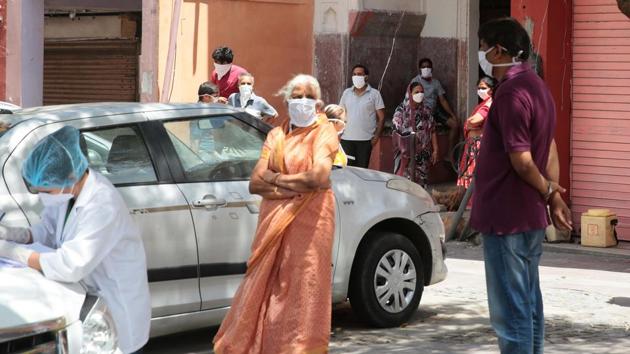A majority of Jaipur’s Covid-19 cases have links to Ramganj superspreader: Collector
The district administration has devised a new strategy of containment to curb the outbreak of coronavirus in Jaipur.
Jaipur has emerged as the biggest Covid-19 hotspot district in Rajasthan, accounting for almost one-third of the state’s total cases. The district administration has devised a new strategy of containment. In an interview to Hindustan Times, District Collector Joga Ram elaborates on the interventions and talks about the superspreader. Here are a few excerpts from the interview:

Q: As Covid-19 cases in Jaipur continue to rise, the obvious question is – how many have been caused by the Ramganj superspreader?
A: Mohd Mubarak from Ramganj is responsible for at least 232 cases, directly and indirectly. His two friends, Hanif and Iqbal, who were infected by him, spread it further. According to our records, Mubarak’s direct contacts gave way to 94 cases and the remaining spread through Hanif and Iqbal. Mubarak was discharged from SMS Hospital on April 2 and shifted to RUHS [Rajasthan University of Health Sciences] for quarantine. Some of his relatives are also with him there.
Q: Why has the famous Bhilwara model of containment failed in Jaipur?
A: Bhilwara and Jaipur are two different worlds. Just for an understanding, Jaipur’s population is 20 times that of Bhilwara’s population. In Jaipur, there are around 8,00,000 people in the walled city area alone. In Jaipur, one issue was quantum and density of population and the second issue was sociological – we faced resistance from people during sampling and when we tried to put them in government quarantine facilities.
Q: What did you do to overcome this resistance?
A: We distributed around 1,00,000 pamphlets with information about why testing was important and how it is done. Then we engaged religious leaders and clerics to record video messages and circulated them on WhatsApp groups. The religious leaders also made announcements on loudspeakers that people should cooperate with medical teams. Local representatives and officers of a particular faith also convinced people. After that we started aggressive testing and the high number of cases could be because of mass testing which was done.
Q: Is it also true that people from the walled city were reluctant to go to government quarantine centres?
A: Yes, there was resistance over that, too. But gradually people understood that isolation was for their own good. As of Wednesday evening, there are 1,500 people under home isolation and 980 in institutional quarantine.
Q: How many samples have you tested?
A: We have tested about 8,000 samples so far, which is the highest in the state. Testing happened at three levels: one was of symptomatic cases; second was at health centres where suspected cases voluntarily came forward; and the third was for academic purpose where we picked 30 samples each from 30 clusters. From Wednesday, we have also started random sampling outside the walled city area. 10 teams are on the move, picking up samples from all parts of the city, and 10 are static.
Q: What is the latest containment strategy?
A: We have identified an area of 1km by 1km in the walled city which is responsible for most of Jaipur’s cases. Mubarak’s house is also in this area. By 1pm on April 15, this area accounted for 395 cases. (The total in Jaipur is 468). This is the area that needs to be managed. On Wednesday, we sealed this area completely – no movement, no exemptions. We will get everything delivered to people’s doorstep but no one will be allowed to move in or move out. There are narrow and congested lanes that have been barricaded. The entire area has been divided into 13 clusters.
Q: Will the people in this area not be allowed to go out even for ration?
A: No. There’s a complete shutdown. There are around 8,000 households in this area and we have given each of them two kits of dry ration free of cost. Each kit contains 5 kg wheat flour, 1kg rice, 1 kg daal, 1 kg salt, half litre cooking oil, 500 grams each of chilli powder and turmeric powder, one soap, one 180 ml bottle of sanitiser and masks for each member of the family. With two kits, people won’t need to step out. For vegetables and milk, we will organise home delivery on e-rickshaws.





